Chile's Wine Regions
Profiles of Chile's Wine Regions
(Adapted from http://www.winesofchile.org/)Limari Valley
Although first planted to vine in 1549 and an important source of wine during colonial times, wine grape production fell off centuries ago and the valley became known for its luscious tropical fruit, juicy table grapes for export, and the aromatic white muscat varieties for Pisco, Chile's favourite distilled spirit. Viticultural interest in the Valley was renewed in the early 1990s when technological advances allowed for new uses of this semi-arid and relatively infertile land. With just 80-100 mm (3.2-4 in) of rainfall per year, drip irrigation is essential for managing vines. Despite its semi-arid, Mediterranean climate and high summer temperatures, the Limarà Valley is an oasis for fine wine production. It is a transversal valley, extending from the majestic Andes eastward to the Pacific Ocean, which allows the curious "Camanchaca" fog to blanket the area with cool air each morning, and coastal breezes to reach inland to maintain mild summer temperatures. Approximately 400 km (250 mi) north of Santiago and approaching the southerly edge of the Atacama Desert, the Valley is home to a variety of national parks, international observatories, hot springs, archaeological sites, dazzling beaches, and the colonial city of La Serena, making it a favourite vacation spot as well as an exciting wine region.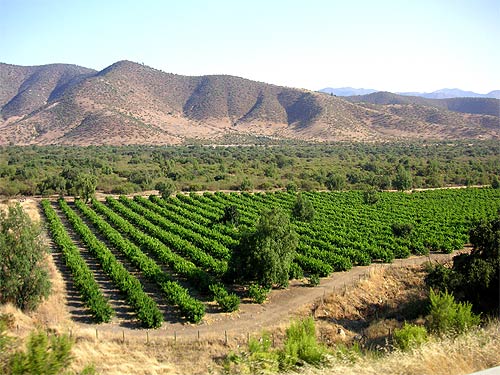
A typical site at the foothills of the Andes.
Colchagua Valley
The Colchagua Valley is the larger and southernmost of the Rapel Valley's two sub-appellations. In little more than ten years, the Valley transformed itself from a sleepy, fertile farming area to a leading producer of some of Chile's finest red wines, and many long-time grape growers have established their own wineries and now offer wines under their own labels. Particularly worth watching are the expressive, full-bodied Cabernet, Carmenerre, Syrah, and Malbec. Many of the high-yielding varietal vineyards that once covered the fertile Valley floor have been replaced by meticulously-selected clonal varieties, vertically-positioned, and carefully-managed to control vigor.
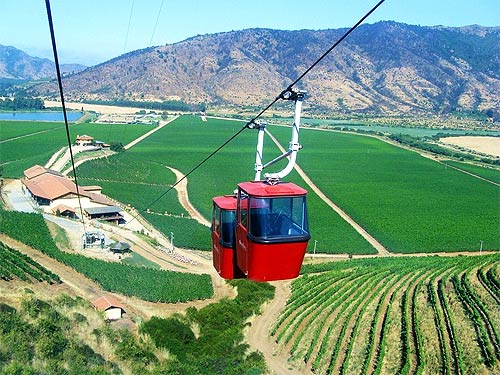
Lift scene over the Colchagua Valley Vineyards.
Vineyards now climb increasingly higher up the steep hillsides in search of the best possible balance between vine and the elements. Colchagua lies closer to the low and rolling Coastal Range than to the higher Andes and benefits from the cooling breezes that blow in directly from the sea, effectively extending the growing season for a long, slow ripening period. In fact, temperatures vary widely on any given summer day, which further contributes to the expressive, fruity, well-balanced character of the wines crafted here. The heart of the Valley's wine-growing area consists of San Fernando, Nancagua, Santa Cruz, Palmilla, and Peralillo, but enterprising efforts are pushing toward the sea and into the Marchihüe and Lolol areas. Other innovations include a growing shift toward organic and even biodynamic agriculture.
Aconcagua Valley
At 22,828 feet (6,956 meters), Mt. Aconcagua, the highest mountain in the Americas, towers over the Valley. It not only lends beauty to the horizon and attracts serious mountain climbers from around the world, but its snow-capped peak provides the irrigation water essential for agriculture in the Valley below. The region is primarily dedicated to fruit, vegetable, and flower production, but has produced wine grapes-mostly Cabernet Sauvignon-since the mid-19th century. The possibility of incorporating drip irrigation sparked renewed interest in the Valley beginning in the 1980s. The region pioneered the planting of Syrah in Chile and currently has large extensions of land dedicated to organic and biodynamic viticulture.
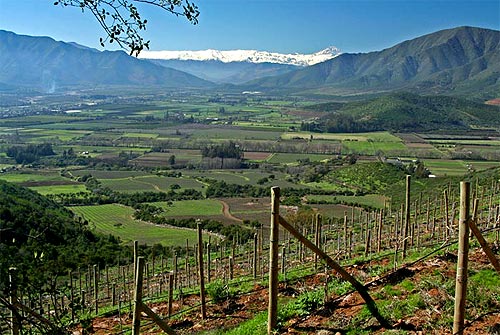
The Sena Vineyard in the Aconcagua Valley.
Casablanca Valley
The Casablanca Valley is Santiago's gateway to the sea. Anyone making the 1.5-hour trek between the capital and the major port of Valparaiso cuts directly across the Valley, now heavily planted to vines. Given that the highway is one of the country's most heavily travelled thoroughfares, the Valley's vineyards are among the most visible in the nation. This wasn't always true however. The first vineyards appeared little more than twenty years ago. Credit for the 'discovery' of the Valley is generally given to winemaking pioneer Pablo Moranda, who was looking for a cooler sector more appropriate for white grapes. Time, temperature, and maritime influence-not to mention international recognition-have long since confirmed his hunch, and the number of hectares dedicated to winegrowing expanded radically in the 1990s. Today a score of producers tend nearly 4,000 hectares of vines in the Valley. Knowledge of the area has expanded along with the plantations, and the Valley is no longer considered homogenous. An ample diversity of soil types and myriad microclimates are now recognized and incorporated into the decision-making process when new vineyards are planned. The higher, warmer, frost-free sections are suitable for some more forgiving black varieties, while the lower, cooler areas produce excellent fruit for cold-loving Sauvignon Blanc, Chardonnay, and Pinot Noir. Frost-prone sectors along the Valley floor are often equipped with windmills that churn the icy pre-dawn air to keep the temperatures just above freezing to protect the fruit. In recognition of certain similarities between Casablanca and California's Napa Valley, the two valleys signed an alliance in 2002, prompting Casablanca to create a wine route and develop tourist attractions in the area. A number of wineries, some of which offer excellent restaurants, are easily accessible directly from the highway.
San Antonio Valley
San Antonio, which includes the now-famous Leyda zone, is one of the one of Chile's smallest viticultural areas. With vineyards as close as 4 km (2.5 mi) from the sea, it is also the most maritime region. The exploration for new terroir suggested that this area would be suitable for cool-climate varieties, such as Sauvignon Blanc, Chardonnay, and Pinot Noir, and the results are more than encouraging. Cooler temperatures mean longer ripening periods and crisper acidity for leaner, more food-friendly wines. Some producers have experimented with other red varieties such as Syrah, which is normally planted in warmer zones such as Aconcagua and Colchagua. The result is a cool-climate Syrah that is causing many to re-think the concept of Chilean Syrah. Irrigation is clearly a concern here, and it is a prevailing factor in determining how much of the area can or will be planted. One determined producer constructed an 8-km aqueduct to feed his drip-lines.
Maipo Valley
The expansive and varied Maipo Valley is nestled between two mountain ranges, the Andes and the Coastal Mountains, and Chile's capital city, Santiago, sits in the middle. Due to the easy access to the surrounding agricultural areas, it comes as no surprise that many of the country's best-known and most traditional wineries were established in close proximity to the city. In the 19th century, when many wealthy industrial families planted vineyards near their country homes to the east and southeast of the capital, surely they never dreamed that the city would grow to engulf them. But today the city of 6,000,000 people continues to stretch out into the surrounding areas. Winemaking in the Maipo Valley today ranges from tiny boutique efforts to large-scale multi-million litre production centres, from nascent dreams to time-honoured traditions, from industrial-scale to biodynamic-and everything in between. The cause is not lost on foreign investors either. Winery architecture is equally diverse and includes everything from treasured national monuments to prize-winning ultra-modern designs.
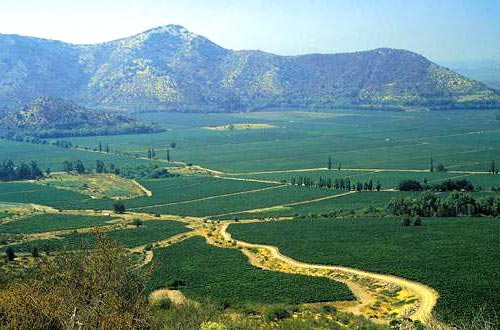
Maipo Valley
Although Chile's appellations of origin are defined from north to south, winemakers now generally agree that conditions vary much more widely from east to west, as the Maipo Valley clearly illustrates. Winemakers unofficially divide the valley into three distinct sectors: Alto Maipo, closest to the Andes; Central Maipo, along the Valley floor; and Pacific Maipo in the sector closest to the Pacific Ocean. All three enjoy a winemaker's ideal Mediterranean climate with hot, dry summers and cool rainy winters, but vary with respect to the degree of influence received by the mountains or the sea. At more than 650 meters (2,133 ft) above sea level, the Alto Maipo sector (sometimes referred to as the Andean or Upper Maipo) rises ever higher into the foothills southeast of Santiago and is strongly influenced by the mountains. Vast differences between daytime and night time temperatures encourage complex, richly colored wines and firmly structured tannins that give rise to a number of Chile's ultra-premium wines. To the south and southeast of Santiago, Central (or Middle) Maipo ranges from 550 to 650 meters (1,800-2,139 feet) above sea level, while the easternmost Pacific (or Lower) Maipo sector nearest the coast comprises areas below 550 meters (1,800 ft) above sea level. These areas tend to have warmer temperatures and more fertile soils, giving rise to softer, fruitier wines. Many winemakers blend wines from different Maipo vineyards to take advantage of the diverse qualities available in the three distinct areas.
Cachapoal Valley
The Rapel Valley, comprised of two sub-appellations, Cachapoal and Colchagua, begins just 100 km (62 miles) south of Santiago. Cachapoal is the northernmost of the two and is itself further divided from east to west. The majority of the wineries are located in the cool eastern sector between the Pan-American Highway and the Andes Mountains around Requingua and Rengo. On the opposite side of the highway and approaching the Coastal Mountains, the western sector around Peumo receives just enough cool maritime influence to create a warm, but not hot climate ideal for the area's distinctive, full-bodied, fruit-forward Carmenère. Black grapes predominate in the Valley, although there are specialized pockets of hillside Chardonnay as well. Virtually all of the vineyards are drip-irrigated due to the naturally arid conditions. Harvest begins with Chardonnay in late February and ends with Carmenère in April or early May. Less than 100 km from Santiago, Cachapoal provides a glimpse of history transformed. Modern huasos (Chilean cowboys) wear the same wide-brimmed, flat-topped hats (called chupayas) that their grandfathers did, although today they participate in rodeos for sport and ride horses for pleasure. Perhaps nowhere else is the success of Chile's wine business and economy in general more evident than in the size and styles of the powerful 4-wheel drive pick-up trucks they drive today.
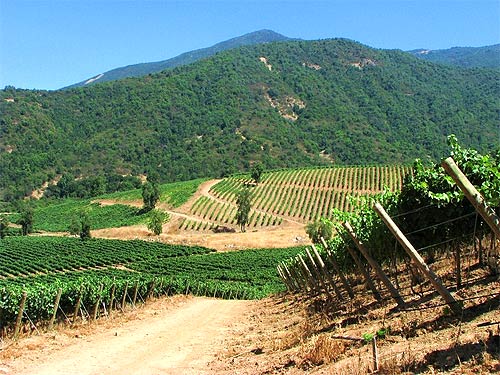
Cachapoal Valley.
Curico Valley
Curico is Chile's second largest wine producing Valley. Only its southern neighbour Maule has more area planted to vine. French Vitis vinifera vines were first planted here in the mid-1800s, and most of Chile's top producers have vineyards, with or without cellars, in the region. Curico's modern winemaking history began, however, when Spanish producer Miguel Torres began his first New World endeavour here in the 1970s. Numerous factors, such as the Mediterranean climate, a 5-month summer dry season with an average temperature of 20°C (68°F) and a maximum of 30°C (86°F), sufficient rainfall (700 mm / 28 in) and well-drained alluvial soils make this Valley viti / viticulturally attractive. Winemaking is the region's primary economic activity. This relatively large valley is sub-divided into the Teno River Valley to the north, and the Lontué River Valley to the south. Most of the area's winegrowing and winemaking activity is concentrated in Lontue, primarily near the town of Molina. The two rivers come together to form the Mataquito River, which flows out through the Sagrada Familia to the sea. Curicó's winding rivers and diverse geographic landscape provide the opportunity to work with many different varieties. In fact, national statistics (SAG) list 32 different types of wine grapes grown in the area (17 red and 15 white). Curicó is also home to the country's largest vineyards, and vast extensions of vine-laden lands are visible from the highway. In fact, travellers heading south to the Lake Country pass through one section of 8 km (5 mi) without interruption.
Maule Valley
Maule is Chile's largest producing valley, with 43% of the country's total planted area concentrated here at the southern end of the long Central Valley. Once predominately planted to the rustic variety Paes, many of the older, head-trained vines have now given way to vertically-shoot positioned Cabernet Sauvignon, while Merlot, Cabernet Franc and Carmenere follow close behind, and there is an impressive assortment of varieties lending new expression to the valley. This is one of Chile's most geographically diverse valleys, and it can be divided into the Pacific, Inter-Andes-Pacific, and Andes regions. The climate is Mediterranean sub-humid throughout, with variations in the different sectors. The Pacific section, closest to the Coastal Mountain range, has higher temperatures and lower rainfalls (700 mm / 28 in per year), while the opposite is true when moving toward the Andean piedmont with average annual rainfalls of up to 1,000 mm (39 in). Add to this a broad range of soil types and it is easy to see why there are a diversity of flavours and styles being developed in the Maule. Several large international investors (California's Kendall Jackson amongst others) have been attracted to this region. It also has many small boutique style independents. Chile's first organic wines were produced in this area in Cauquenes.
Itata Valley
The northernmost sector of the 3-valley 'Southern Region,' Itata is no newcomer to wine. Some of the earliest vineyards were planted near the port city of Concepcian during colonial times. The Spanish black grape Paes still predominates in the area, although Cabernet Sauvignon leads the selection of French varieties. Muscat of Alexandra is the front-runner in white grape production, but its Chardonnay is the attention-getter. In colonial times, it was the abundant water supply that attracted winemakers. Annual rainfall is concentrated during the winter months and averages more than 1,100 mm per year, alleviating the need for extensive irrigation systems. Interest dwindled as winegrowing became more viable closer to Santiago. Today however, improving transportation systems and the drive for new terroirs have led a handful of new wineries to set up in Itata, where shining stainless steel tanks and vertically-trained vines provide odd contrast to traditional head-trained vines and ancient woary to apparent logtter than Maipo, which is more than 500 km (310 mi) closer to the equator! Temperatures swing widely during the course of the day, and the quality of the light encourages excellent colour development in the grapes.
Itata Valley Vineyard
Bio Bio Valley
With an average rainfall similar to that of the Medoc (more than 1,300 mm / 51 in per year), a deep and generous subterranean water table, and cool evening mists that creep down the Andean foothills, the Bio Bio is both blessed and challenged. Fruit ripens slowly this far south, and the harvest begins a full 20 to 25 days after the harvests in more northerly valleys have reached full swing. Rain and cold weather make winegrowing here more complicated than in other areas. Traditionally the vineyards were massively planted with the little-demanding variety Paes used in simple rustic wines for local consumption. Today enterprising winemakers have initiated a transition toward more exciting varieties less suited to the warm conditions in Chile's more northerly climes. Chardonnay, Gewurztraminer, and Riesling express themselves very well here with higher acidities closer to those found in Old World bottlings.
Malleco Valley
Malleco is currently Chile's southernmost appellation, although experimental vineyards have been planted much further south in Osorno. The conditions are cold and very rainy this far south. Chardonnay does quite well, but most varieties do not reach maturity here. Wine grapes are grown under similar conditions in other countries, such as France, but the vinification process requires chaptalization, which is illegal in Chile.
